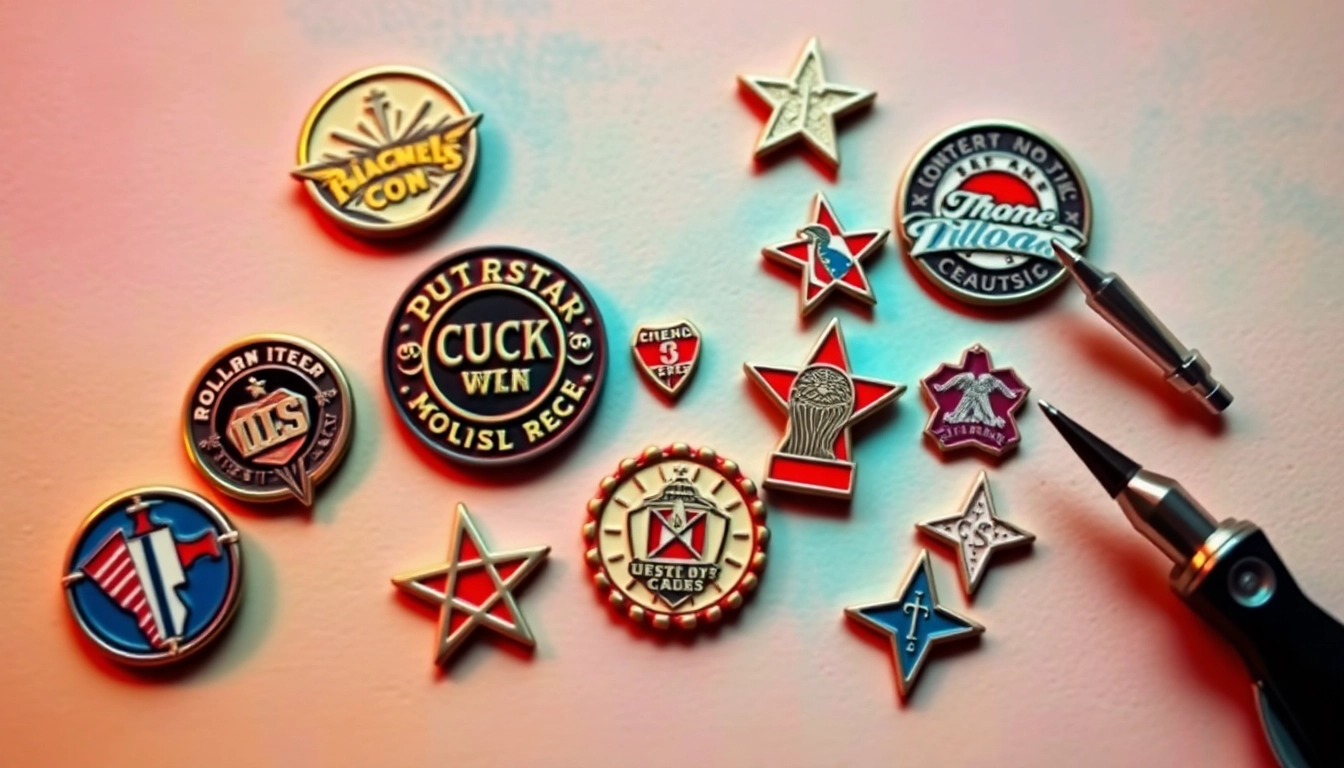Understanding Custom Pins
What are Custom Pins?
Custom pins are small, decorative items typically worn on clothing or accessories to communicate a message, promote a brand, or signify membership in a group. They can be made from various materials, including metal, enamel, and plastic, and are often designed to feature logos, personalized artwork, or slogans. The versatility of custom pins makes them a popular choice for companies, organizations, and individuals alike, creating a unique identity and conveying affiliation or support for causes.
Types of Custom Pins Available
When considering the world of custom pins, it is essential to understand the different types available, as each type serves distinct purposes and styles:
- Soft Enamel Pins: These pins have a raised metal design with colored enamel filling. They provide a textured feel and can be produced in various colors, making them a favorite for artistic designs.
- Hard Enamel Pins: Unlike soft enamel pins, hard enamel pins are polished down to create a smooth surface. They offer a more refined finish and are often used for corporate branding.
- Die-Strike Pins: These pins are made by striking a design into a metal surface, creating a raised effect that can be filled with color. They are highly durable and are often seen in military or association insignias.
- Offset Printed Pins: Ideal for detailed images and designs, these pins have a smooth surface. Their designs are printed directly onto the metal, allowing for fine details and vibrant colors.
Common Uses for Custom Pins
Custom pins are used across various settings for multiple purposes:
- Corporate Branding: Companies frequently use pins as promotional giveaways. They serve to increase brand visibility at events and foster a sense of belonging among employees.
- Event Promotions: Whether for conferences, trade shows, or fairs, custom pins can generate interest and act as a memorable takeaway for attendees.
- Fundraising and Awareness Campaigns: Non-profit organizations often employ pins as part of their fundraising efforts or to raise awareness for specific causes, allowing supporters to wear their commitment.
- Group Membership: Clubs, schools, and organizations use custom pins to signify membership, serving as a badge of honor for their members.
Benefits of Using Custom Pins
Enhanced Brand Visibility
One remarkable benefit of custom pins is their ability to elevate brand visibility. When worn by individuals at events, meetings, or within the community, these pins act as walking advertisements. The colorful designs and unique branding make them eye-catching and memorable, leading to increased recognition of the associated brand or cause.
Catering to Diverse Audiences
Custom pins appeal to a wide demographic, making them effective promotional tools. Their diverse range of designs allows organizations to target different age groups, styles, and preferences. For example, younger audiences may prefer trendy enamel pins, while corporate entities might lean towards classic hard enamel varieties. This flexibility ensures that businesses can connect with various audience segments effectively.
Cost-Effective Marketing Tool
Compared to other marketing strategies, producing custom pins is relatively inexpensive while still providing significant marketing potential. They can be ordered in bulk, and their low production costs, coupled with high perceived value, make them an ideal promotional item, especially for startups and organizations working within constrained budgets.
Designing Your Custom Pins
Key Design Elements to Consider
Effective designs for custom pins involve several key elements:
- Color Palette: Choose colors that resonate with the brand or message. Limiting the palette to two or three colors can enhance clarity and impact.
- Typography: Any text included should be clear and legible. Selecting the right font style contributes to the overall aesthetics and legibility.
- Imagery: Incorporate symbols, logos, or illustrations that are meaningful to the target audience. This enhances recognition and emotional connection.
- Size and Shape: The size and shape of the pin can influence its wearability and visibility. Standard shapes include circles, squares, and custom outlines that reflect the brand or theme.
Best Practices for Effective Branding
To ensure custom pins reflect the brand identity effectively, consider the following practices:
- Consistency: Align design elements with the overall branding strategy, including colors, logos, and messaging.
- Originality: Stand out by creating unique designs that differentiate your pins from competitors. Avoid clichés and strive for creativity.
- Target Audience Feedback: Before finalizing designs, gather input from the target audience. Understanding their preferences can lead to more appealing products.
Utilizing Design Software for Custom Pins
Several design software solutions can aid in the creation of stunning custom pins:
- Adobe Illustrator: A professional tool ideal for creating vector graphics, allowing for high-quality designs that can be scaled without loss.
- Canva: A user-friendly platform that provides templates and design elements. It is suitable for beginners who wish to create visually appealing pins easily.
- Inkscape: This open-source vector graphics editor provides a viable alternative for those who prefer not to use subscription-based software like Adobe.
Ordering Custom Pins: A Step-by-Step Guide
Finding the Right Manufacturer
The first step in ordering custom pins is selecting a reputable manufacturer. Begin by researching potential suppliers, checking reviews, and comparing pricing structures. Look for companies that specialize in custom pins and offer a range of options, including different types of pins, materials, and finishes. Request samples to assess quality and craftsmanship before making a decision.
Submitting Your Designs
Once a manufacturer has been selected, prepare to submit your designs. Export your designs in the required file formats, typically Vector (.ai, .eps) or high-resolution raster images (.png, .jpg). Many manufacturers have specific design guidelines that outline necessary requirements for color, size, and format. Be sure to follow these guidelines closely to avoid delays in production.
Understanding Production Timelines
Production timelines can vary significantly based on the manufacturer, order quantity, and complexity of designs. Typically, custom pins can take anywhere from a few days to several weeks for production. When placing your order, inquire about estimated production and shipping times to plan accordingly, especially for events or promotional timelines.
Measuring the Success of Your Custom Pins
Tracking Brand Engagement
To assess the effectiveness of custom pins as a marketing tool, it’s essential to track brand engagement. Monitor how often and where your pins are being used or worn. Social media offers a fantastic way to gauge engagement; encourage followers to share photos of themselves wearing the pins and tag your brand. This can create buzz and increase visibility.
Collecting Customer Feedback
Gathering feedback from customers can provide valuable insights into how well the pins are received. Surveys, direct messages, and reviews can help determine what customers like or dislike about the designs, quality, and usability. This information can be crucial for improving future designs and marketing strategies.
Analyzing Sales Impact of Custom Pins
Finally, analyze the sales impact of custom pins within your marketing campaign. Track the spike in sales correlated with pin promotions or events. This data can help quantify the return on investment (ROI) for custom pins as a promotional tool and guide future decisions about usage and design.



